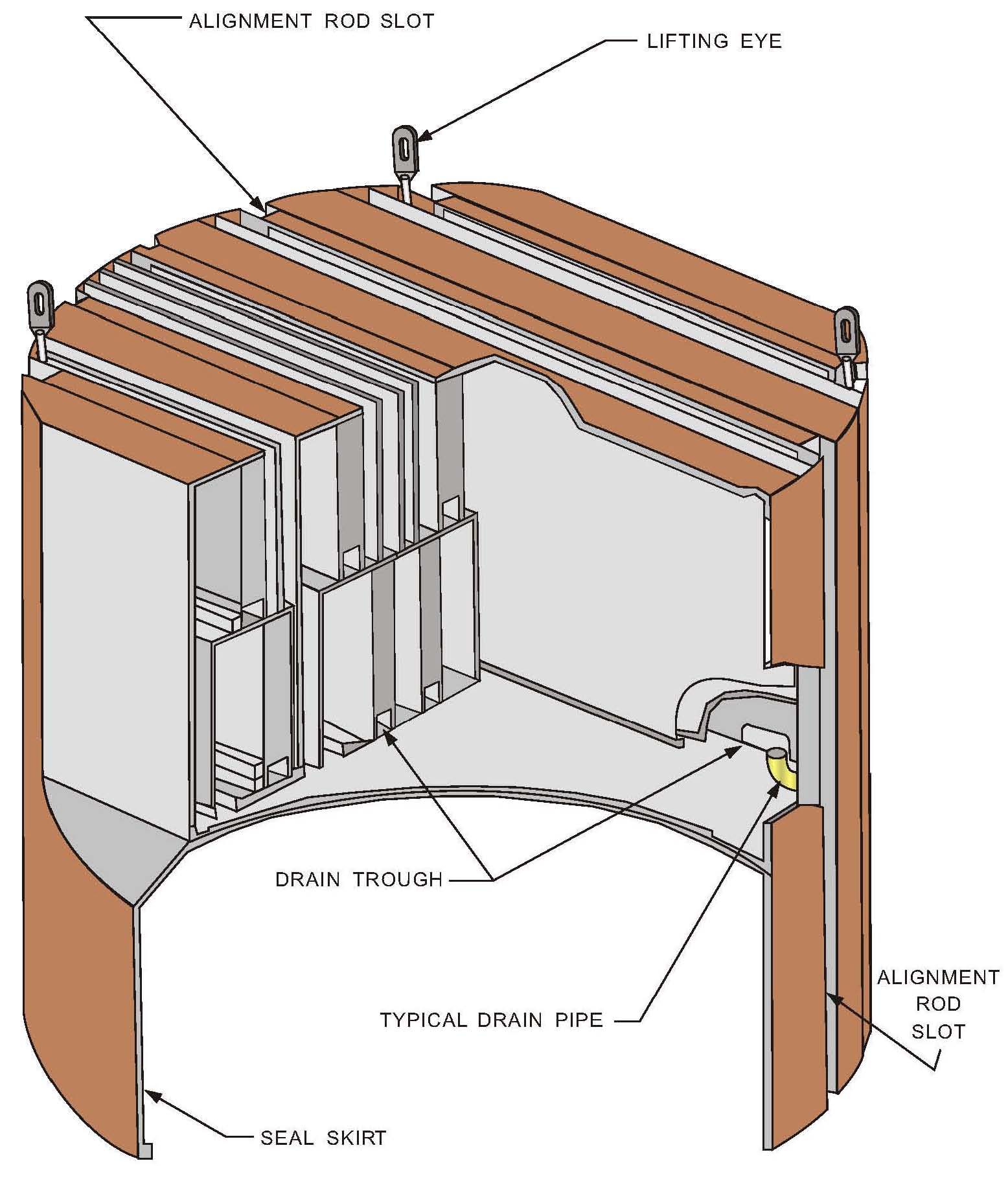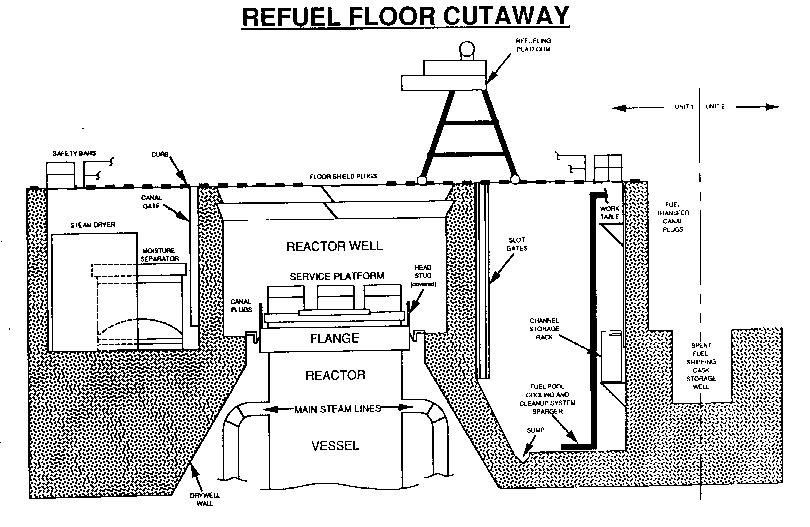On March 5, 2011, operators at the Monticello nuclear plant in Minnesota shut down the reactor to enter its 25th refueling outage. Monticello has a boiling water reactor with a Mark I containment design like the Unit 2 reactor at Fukushima Daiichi.
During the refueling outage, workers replaced the steam dryer. In a boiling water reactor, the steam dryer, a large metal component with no moving parts, rests above the nuclear core inside the reactor vessel. The steam created when water is heated to the boiling point while flowing through the core passes through another large metal component with no moving parts called the steam separator. Water droplets carried upward by the steam flow are removed as they pass through the steam separator and steam dryer. The dryer’s vertical panels have holes in them not unlike a cheese grater. Steam navigates its way through this metal maze while heavier water droplets tend to get snagged and left behind. The result is steam containing very few water droplets, also called clean or dry steam, which leaves the reactor vessel via four pipes to the turbine. The water removed from the steam drains by gravity down to re-enter the nuclear core for another chance of becoming steam.
Steam dryers were originally expected to last the entire 40-year operating lifetime of the reactor. As owners sought and obtained 20-year extensions to reactor operating licenses and also obtained permission to operate reactors at up to 20 percent higher power levels, more and more steam dryers needed replacement to allow reactors to operate longer at higher power levels.
On May 25, 2011, operators restated the Monticello reactor to begin its 26th operating cycle. The old steam dryer was left in the equipment storage pool shown to the left of the reactor well in the figure.
On November 12, 2012, workers prepared the steam dryer for shipment to a waste site. The refueling floor’s overhead crane lifted the steam dryer and began moving it laterally towards the equipment hatch. The equipment hatch is a vertical opening extending from the refueling floor down to the first floor of the reactor building. The plan was to lower the steam dryer through the equipment hatch onto a vehicle for transport from the plant site.
That plan was carried out, but not without a bump along the way. En route to the equipment hatch, the radiation emitted from the large metal component that had resided near an operating nuclear reactor for nearly 40 years set off radiation monitors on the refueling floor. The purpose of these radiation monitors is to detect a fuel handling accident (e.g., a spent fuel bundle that is dropped onto other spent fuel bundles in the spent fuel pool breaking some fuel rods and releasing radioactive gases and particles into the water). When the monitors detect high levels of radiation from a fuel handling accident, or irradiated steam dryer, they cause a number of safety actions to automatically occur. For example, the ventilation system for the control room switched from its normal mode to a mode that protects the operators from radioactivity in the air. In addition, the ventilation system for the reactor building was shut down and an emergency ventilation system, called the standby gas treatment system, started. The standby gas treatment system maintains the reactor building at a slightly lower pressure to the outside atmosphere, forcing clean air to leak into the building instead of potentially contaminated air from leaking out.
After pausing to check out the alarms, workers resumed lowering the steam dryer down the equipment hatch towards the first floor of the reactor building. Nineteen minutes after the refueling floor radiation monitor alarmed, the radiation levels dropped low enough that workers could restore all systems to their normal configurations.
Our Takeaway
This incident reminds me of something that happened in the early 1980s when I worked at the Browns Ferry nuclear plant, with three boiling water reactors similar in design and age to Monticello. At the NRC’s insistence, we had to conduct a criticality check of the Unit 1 spent fuel pool. NRC’s regulations require that fuel stored in spent fuel pools have sufficient margin to sustaining a nuclear chain reaction or achieving criticality. A criticality test requires a neutron source, a metal cylinder about the size of a fountain pen. The only neutron source at Browns Ferry rested in a metal container in the Unit 3 spent fuel pool. The Unit 1 and Unit 2 spent fuel pools were cross-connected so things could be moved underwater between them. But the Unit 3 spent fuel pool, while sharing the same refueling floor, was not cross-connected. The neutron source had to be raised out of the Unit 3 spent fuel pool, moved a few dozen feet, and lowered into the Unit 1 spent fuel pool.
Our Nuclear Fuels group and on onsite Reactor Engineering section ran computer programs to calculate the radiation dose from the neutron source. These values were needed to determine how to protect the workers involved in the source’s transfer from excessive radiation exposure.
The calculations were checked and re-checked. Workers headed to the refueling floor to transfer the source. The metal container holding the neutron source broke the surface of the water in the Unit 3 spent fuel pool – and immediately tripped the refueling floor monitors for all three reactors. The metal container was swiftly lowered back into the water.
The ensuing investigation confirmed that the calculation of radiation emitted by the neutron source was very accurate. But we had failed to account for the irradiation of the metal container that had held it for years. The irradiation caused a radioisotope of cobalt, specifically Cobalt-60, to form. The decay chain for Cobalt-60 emits a beta particle, easy to shield against, and to high-energy gamma rays, more challenging to shield against. The open air we had been using on the refueling floor providing no effective protection against the gamma rays.
We re-grouped for Plan B. We dumped the neutron source underwater from its metal container into an unirradiated mesh basket on the end of a long pole. A worker raised the basket from the Unit 3 spent fuel pool, ran down the refueling floor, and lowered the basket into the Unit 1 spent fuel pool.
The Unit 1 spent fuel pool passed its criticality test, but not without a bump along the way.
In both incidents, workers failed to ask and answer enough “what if” questions. The ad hoc responses in both cases sufficiently protected workers and public with considerable margin. But they revealed planning deficiencies that could have contributed to more serious outcomes under different circumstances.
In a report to the NRC about the steam dryer incident , the plant’s owners outlined lessons it learned that would be applied to future activities. Specifically, a procedure governing infrequently performed tasks was revised to better manage risk and provide fuller mitigating actions for unexpected situations.
Such steps enhance nuclear safety by minimizing the number of bumps in the road and their height.
“Fission Stories” is a weekly feature by Dave Lochbaum. For more information on nuclear power safety, see the nuclear safety section of UCS’s website and our interactive map, the Nuclear Power Information Tracker.


